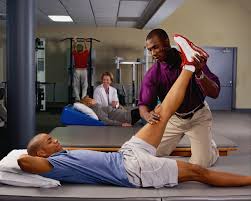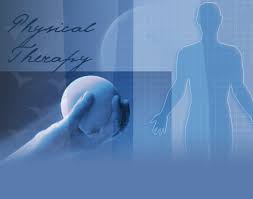1- Orthopedic physical therapists diagnose, manage, and treat disorders and injuries of the musculoskeletal system as well as rehabilitate patients post orthopedic surgery. This specialty of physical therapy is most often found in the out-patient clinical setting. Orthopedic therapists are trained in the treatment of post operative joints, acute sports injuries, arthritis, and amputations just to name a few. Joint mobilizations, strength training, hot/cold packs, and electrical stimulation are modalities often used to expedite recovery in the orthopedic setting. Those who have suffered injury or disease affecting the muscles, bones, ligaments, or tendons of the body will benefit from assessment by a physical therapist specialized in orthopedics.
2-Geriatric physical therapy covers a wide area of issues concerning people as they go through normal adult aging, but is usually focused on the older adult. There are many conditions that affect many people as they grow older and include but are not limited to: arthritis, osteoporosis, cancer, alzheimer's disease, hip and joint replacement, balance disorders, incontinence and more.
Geriatric physical therapy helps those affected by such problems in developing a specialized program to help restore mobility, reduce pain, increase fitness levels and more.
3-Neurological physical therapy is a discipline focused on working with individuals who have a neurological disorder or disease. These include Alzheimer's disease, ALS, brain injury, cerebral palsy, multiple sclerosis, Parkinson's disease, spinal cord injury, and stroke. Common problems of patients with neurological disorders include paralysis, vision impairment, poor balance, inability to ambulate, and loss of functional independence. Therapists work with patients to improve these areas of dysfunction.
4-Cardiovascular and pulmonary rehabilitation physical therapists treat a wide variety of patients with cardiopulmonary disorders or those who have had cardiac or pulmonary surgery. Primary goals of this specialty include increasing patient endurance and functional independence. Manual therapy is utilized in this field to assist in clearing lung secretions experienced in patients with cystic fibrosis. Patients with disorders including heart attacks, post coronary bypass surgery, chronic obstructive pulmonary disease, and pulmonary fibrosis are only a few examples of those who would benefit from cardiovascular and pulmonary specialized physical therapists.
5-Pediatric physical therapy assists in early detection of health problems and uses a wide variety of modalities to treat disorders in the pediatric population. These therapists are specialized in the diagnosis, treatment, and management of infants, children, and adolescents with a variety of congenital, developmental, neuromuscular, skeletal, or acquired disorders/diseases. Treatments focus on improving gross and fine motor skills, balance and coordination, strength and endurance as well as cognitive and sensory processing/integration. Children with developmental delays, cerebral palsy, spina bifida, and torticollis are a few of the patients treated by pediatric physical therapists.




